Table of Contents
Table of Contents
In today's fast-paced business environment, maintaining a reliable and high-performing network is essential. One technology that can help achieve this goal is Meraki SD-WAN (Software-Defined Wide Area Network), a cloud-based solution that enables organizations to easily manage and optimize their network performance.
However, simply deploying SD-WAN is not enough. To ensure that your network is functioning at its best, it's important to implement a comprehensive network monitoring strategy that can detect issues before they become problems.
In this article, we'll explore the benefits of network monitoring for Meraki SD-WAN and discuss how it can help keep your network running smoothly.
Meraki SD-WAN (Software-Defined Wide Area Network) is a networking solution developed by Cisco's Meraki division. It leverages cloud-based technology to provide organizations with the tools to simplify and optimize their wide area network (WAN) infrastructure.
Meraki SD-WAN offers a centralized dashboard that allows IT administrators to configure, monitor, and manage network devices and policies across multiple locations from a single interface. This simplifies network management and reduces the need for on-site configuration.
It can intelligently route network traffic, ensuring that critical applications receive the necessary bandwidth while optimizing less critical traffic for efficiency. Meraki SD-WAN is also cloud-centric, which means it leverages cloud services for various network functions. This provides scalability, flexibility, and the ability to adapt to changing network demands.
Overall, Meraki SD-WAN is designed to make WAN management more efficient, cost-effective, and responsive to the needs of modern businesses with distributed operations. It's particularly beneficial for organizations that require reliable and high-performing networks to support their day-to-day operations and applications.
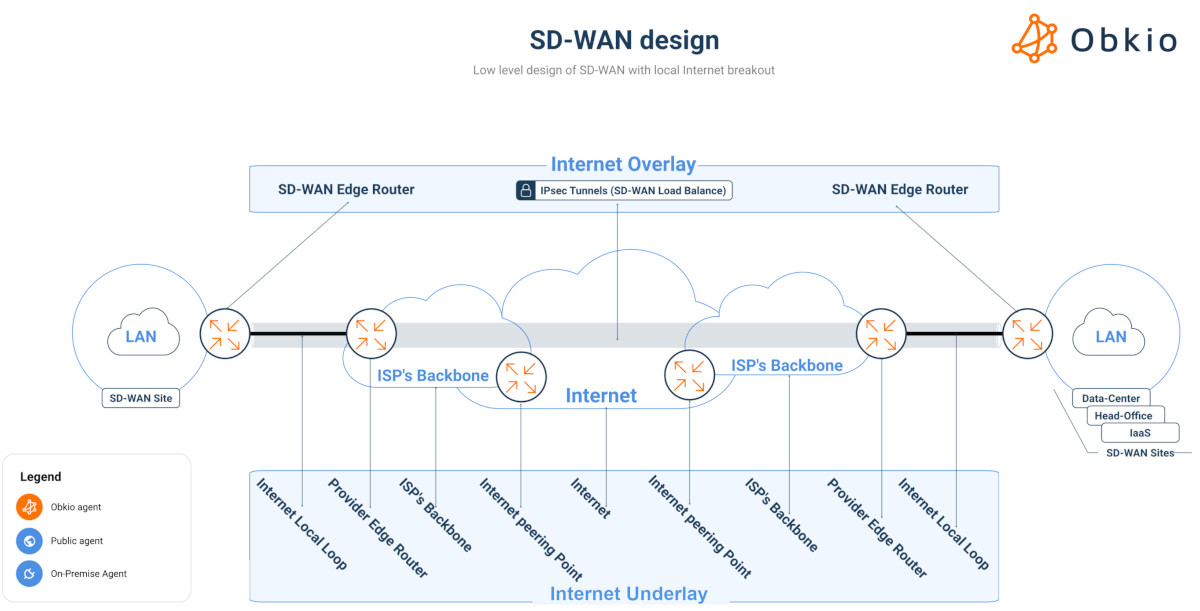

As we discussed earlier, maintaining a high-performing network is crucial for any business, and deploying Meraki SD-WAN can go a long way toward achieving that goal. However, even with SD-WAN in place, it's important to have a monitoring strategy to ensure that everything is running smoothly.
Without monitoring, you could miss critical issues that could impact your network's performance and cause costly downtime.
In this section, we'll explore some of the reasons why Meraki SD-WAN network monitoring is essential for your business, and how it can help you maintain a reliable and high-performing network.
Here are some reasons why you should consider implementing a tool for Meraki network monitoring:
Real-time visibility: With Meraki network monitoring, you can get real-time visibility into your network, allowing you to identify and troubleshoot issues as they arise.
Proactive issue detection: A network monitoring tool can proactively detect potential issues before they become major problems, minimizing downtime and ensuring that your network stays up and running.
Increased network performance: Meraki network monitoring can help you identify bottlenecks and other performance issues, allowing you to optimize your network for maximum performance.
Improved network security: A network monitoring tool can help you detect security threats and vulnerabilities, allowing you to take action before they can cause damage.
Enhanced network management: With a network monitoring tool, you can easily manage your Meraki network, monitor device health and status, and get detailed analytics and reporting.
Cost savings: By proactively detecting and addressing network issues, you can minimize downtime and save money on costly repairs and replacements.
Scalability: Meraki SD-WAN network monitoring tools are designed to scale with your network, so you can easily monitor and manage even large, complex networks.
Compliance: A network monitoring tool can help you ensure that your network is compliant with industry regulations and standards, avoiding costly fines and penalties.
Overall, implementing a tool for Meraki network monitoring can provide numerous benefits for your business, from improved performance and security to cost savings and compliance.

6 Reasons Why a Dedicated Network Monitoring Tool is Essential for Your Meraki Network Monitoring Needs
While some SD-WAN vendors have integrated monitoring features, they may not offer the same level of visiblity as a dedicated network monitoring tool specifically designed for SD-WAN environments. Here are some reasons why you should consider using a dedicated network monitoring tool for your Meraki Network Monitoring needs:
End to End vs. Edge to Edge : Opting for an external solution to monitor SD-WAN network performance instead of relying on the vendor's built-in monitoring is crucial. This is because built-in monitoring only provides edge-to-edge monitoring rather than end-to-end, which focuses on monitoring from the perspective of the edge routers placed between the WAN and LAN. Consequently, without LAN monitoring,the LAN's perspective is lost, leading to restricted network visibility.
Vendor Neutrality : Using the same network monitoring tool as your SD-WAN vendor can result in a lack of vendor neutrality, which can limit your ability to monitor other network devices and services that are not part of your SD-WAN solution. This can lead to an incomplete view of your network performance, making it difficult to identify potential issues and proactively address them.
Comprehensive Visibility: A dedicated network monitoring tool designed for SD-WAN environments can provide comprehensive visibility into network traffic, security, and performance across virtual, physical, and cloud environments, as well as across multiple carriers and service providers.
Customization: Dedicated network monitoring tools often offer greater customization options than general-purpose network monitoring tools like vRealize Network Insight, allowing you to tailor the monitoring tool to your specific SD-WAN environment and business needs.
Proactive Monitoring: A dedicated network monitoring tool can provide proactive monitoring and alerting for potential network issues, allowing you to identify and resolve issues before they become major problems.
Integration: A dedicated network monitoring tool can often integrate with other SD-WAN management tools, providing a comprehensive solution for managing your SD-WAN environment.
Scalability: A dedicated network monitoring tool can scale to meet the needs of large and complex SD-WAN environments, providing the ability to monitor thousands of devices and millions of flows.
In summary, using a dedicated network monitoring tool specifically designed for SD-WAN environments can provide greater customization, comprehensive visibility, proactive monitoring, integration, and scalability for your Meraki Network Monitoring needs.

Looking for a comprehensive and user-friendly solution to monitor your Meraki SD-WAN network performance? Obkio might be just what you need!
With Obkio, you get a solution that's easy to set up and use, providing end-to-end visibility into your network performance. One unique feature of Obkio is its vendor neutrality, which means that it can be used to monitor any network devices and services, not just those that are part of the Meraki SD-WAN solution. This provides greater flexibility and allows you to put together a complete view of your network.
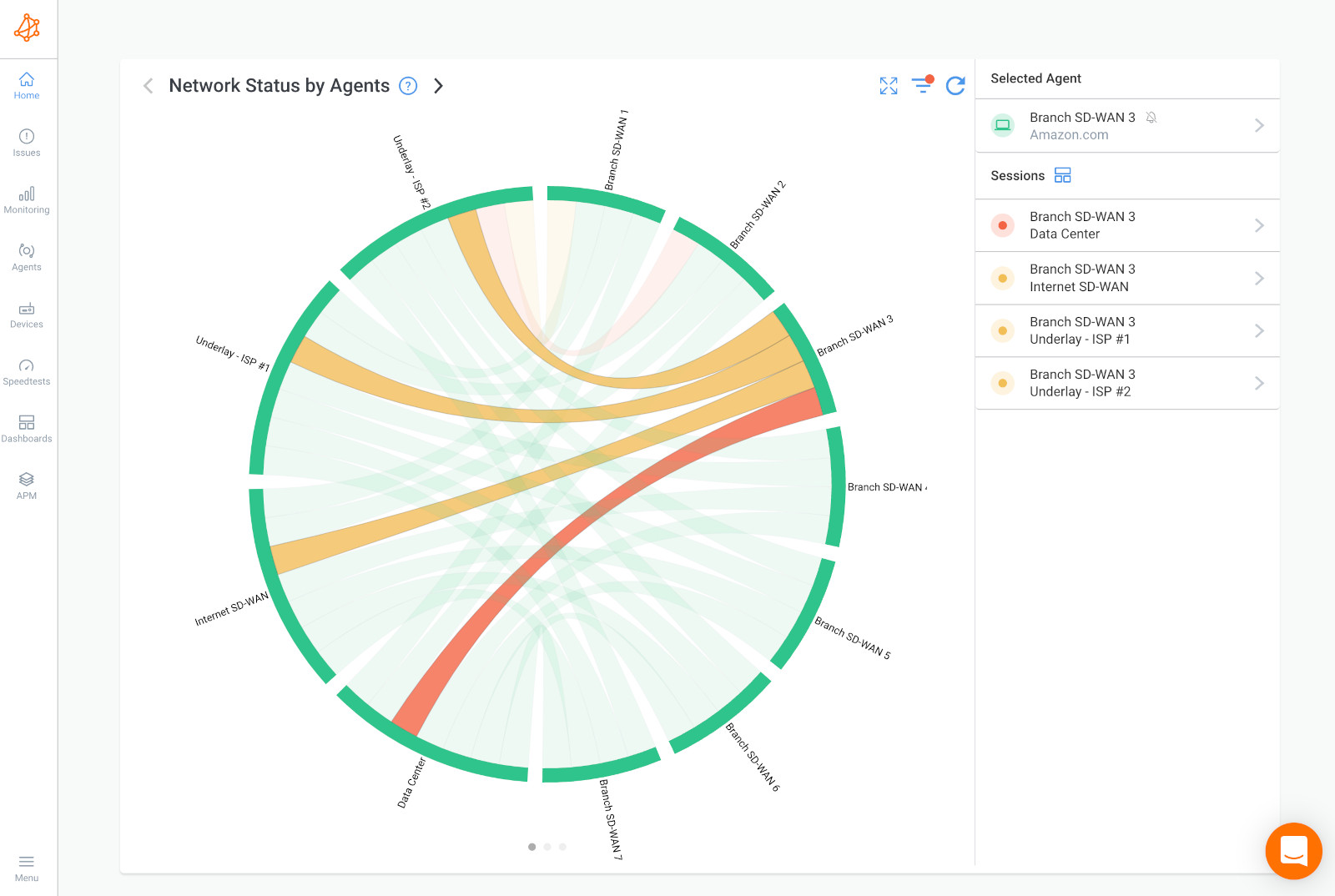
Obkio includes automated network tests and alerts that help IT professionals identify and resolve issues quickly and efficiently, ensuring that your network performance is running smoothly. Plus, Obkio's extensive and accessible documentation makes it easy for IT professionals to get up and running with the tool quickly and find answers to any questions they may have along the way.
Furthermore, Obkio offers flexible and affordable pricing plans, making it a valuable addition to any Meraki SD-WAN monitoring strategy.
Overall, Obkio is a comprehensive, user-friendly, and vendor-neutral solution that can help you optimize your network monitoring strategy. With end-to-end visibility, automated testing and alerts, and accessible documentation, Obkio has everything you need to monitor your Meraki SD-WAN network performance with confidence.
Ready to take your Meraki SD-WAN network performance to the next level?. Don't let any issues dim the light on your network performance - try Obkio's SD-WAN monitoring solution today and see the full picture of your network's potential. Sign up for a free trial now and shine a light on your network's performance!
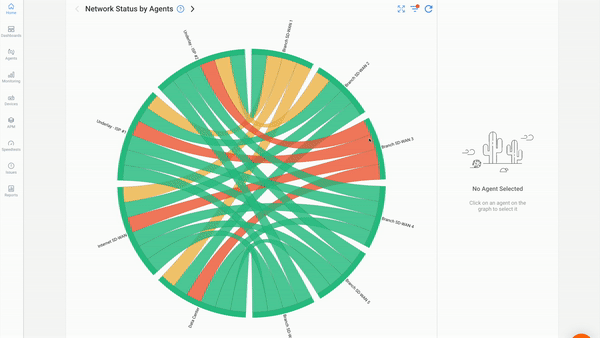
- 14-day free trial of all premium features
- Deploy in just 10 minutes
- Monitor performance in all key network locations
- Measure real-time network metrics
- Identify and troubleshoot live network problems

Boost Meraki SD-WAN Performance and Security with Meraki Network Monitoring Software: Exploring Key Scenarios for Businesses
In the world of network management, the proof is in the pudding. It's all about real-world results, and that's precisely what we're diving into in this section. We'll explore how Meraki Network Monitoring Software comes to life in various practical scenarios, showcasing its remarkable impact on Meraki SD-WAN. From remote work connectivity to optimizing multi-site networks, we'll provide hands-on examples that demonstrate the genuine value of this software.
Network monitoring software can be a valuable tool for troubleshooting network issues affeting Meraki SD-WAN. By proactively monitoring network performance, you can identify and address potential issues before they become major problems, minimizing downtime and ensuring optimal network performance.
Network Monitoring Software can actively scan your network and Meraki SD-WAN service for anomalies or irregularities. When it detects issues, such as network congestion, packet loss, or latency spikes, it alerts administrators in real-time. This early detection allows for swift action to prevent issues from escalating.
Learn how to troubleshoot SD-WAN issues using Obkio Network Monitoring software and key SD-WAN troubleshooting steps.
Learn more

Monitoring the migration process when transitioning to Meraki SD-WAN is crucial to ensure a seamless transition and minimize potential disruptions. Network monitoring software can provide real-time visibility into network performance, allowing you to quickly identify and troubleshoot issues as they arise during the migration process.
- Pre-Migration Assessment: Before starting the migration process, Meraki Network Monitoring Software can evaluate the existing network infrastructure. It helps identify areas that might require special attention during the migration, such as critical applications, network paths, or potential bottlenecks.
- Configuration Validation: During the migration, the software can continuously validate the configurations to ensure that they align with the intended design. Any deviations or misconfigurations can be detected and rectified promptly, reducing the risk of post-migration issues.
- Performance Monitoring: Throughout the migration process, the software provides real-time visibility into network performance. This includes monitoring for latency, packet loss, and bandwidth utilization. If performance issues arise, the software can detect them early and facilitate quick remediation.
- Post-Migration Validation: After the migration is complete, the software helps validate that the network is operating as expected. It can compare the pre-migration and post-migration performance metrics to ensure that the transition has been successful.
Learn how to monitor SD-WAN migrations with Network Monitoring for complete visibility over your SD-WAN service, before, after & during migrations.
Learn more

In today's work landscape, remote work has become the new norm. The ability to keep remote employees connected seamlessly is a top priority for businesses. Meraki Network Monitoring Software steps in as the hero in this scenario. It actively monitors the network to ensure high-performance connections, which is a game-changer for remote work.
This means fewer hiccups, minimal downtime, and maximum productivity, no matter where your employees are located. Whether they're working from the comfort of their home office or from a coffee shop halfway across the world, Meraki Network Monitoring Software keeps the virtual doors open and the lines of communication clear. Your team can work without interruption, collaborate effectively, and deliver their best, all thanks to this essential tool.
For businesses with multiple locations, the task of managing network performance across various sites can be a complex puzzle. Meraki SD-WAN, coupled with a tool like Obkio's Network Monitoring software, offers an elegant solution. Rather than directing traffic, the software utilizes Monitoring Agents to continually monitor and assess the performance of all locations. It becomes the watchful eye that keeps tabs on your network from anywhere.
These Monitoring Agents are strategically placed across your network, collecting valuable data on network health, latency, packet loss, and more. This information is then consolidated, providing a centralized, real-time view of your entire network infrastructure.
The beauty of this setup is that it allows for swift issue identification and troubleshooting. If an issue crops up in one location, whether it's a dip in performance or an unexpected outage, the Monitoring Software can spot it and alert administrators. With this proactive approach, problems can be addressed promptly, minimizing disruptions and maintaining network reliability across all branches. It's like having a team of dedicated experts who are always on the lookout, ensuring your multi-site business runs smoothly.
In the world of network management, having a clear, real-time view of your network's health is like having a GPS for your digital journey. Meraki Network Monitoring Software offers precisely that – a real-time dashboard of insights into the pulse of your network.
At its core, this means that at any given moment, you can see how your network is performing. You don't have to wait for issues to manifest as complaints from users or disruptions in operations; the software provides a proactive window into your network's vitality.
1. Monitoring Bandwidth Utilization: Picture your network's bandwidth as a highway. The software gives you a live traffic report, showing which applications are hogging the lanes and which are cruising smoothly. You can spot if, for example, video conferencing is consuming too much bandwidth, impacting other essential operations. Armed with this insight, you can make informed decisions on bandwidth allocation and application prioritization.
2. Identifying Bottlenecks: Bottlenecks are like traffic jams on your network highway. They slow down data transfer and disrupt the flow of information. Meraki Network Monitoring Software can instantly pinpoint where these bottlenecks occur. With this knowledge, you can address them swiftly, whether it's by adding additional capacity, reconfiguring routing, or optimizing your network design.
3. Historical Data for Informed Decisions: The software doesn't just offer real-time insights; it's a treasure trove of historical data. You can look back at network performance over days, weeks, or months. This data isn't just for nostalgia; it's your toolkit for making informed decisions for network optimization. It helps you spot trends, plan for future growth, and validate the impact of any changes you implement.
This combination of real-time monitoring and historical data is your secret weapon in maintaining a network that's robust, efficient, and always ready for the challenges of the digital age. It's like having a crystal ball for your network's future, ensuring that you're always one step ahead in delivering top-notch performance and staying responsive to the ever-changing demands of your users.
Learn how to monitor SD-WAN networks with Network Monitoring to get complete visibility over your SD-WAN service and identify SD-WAN issues.
Learn more

Using Network Monitoring software for Meraki SD-WAN Capacity Planning is the strategic compass that guides businesses towards optimized network performance.
At its core, network capacity planning involves understanding your network's limits and finding ways to operate within them efficiently. Meraki Network Monitoring Software is the key to unlocking this understanding. Here's how:
1. Network Traffic Insights: The software acts as a constant observer, tracking the ebb and flow of network traffic. It identifies when and where traffic surges occur, providing a real-time, comprehensive view of usage patterns. This information is invaluable for predicting trends and understanding peak usage periods.
2. Bandwidth Usage Visibility: Understanding how your bandwidth is utilized is like having X-ray vision for your network. The software provides detailed data on which applications are consuming bandwidth and how much they require. With this clarity, you can make data-driven decisions on bandwidth allocation and prioritize applications that are crucial for your business.
3. Application Performance Assessment: Not all applications are created equal, and their performance can vary significantly. Meraki Network Monitoring Software offers a magnifying glass into the performance of each application running on your network. You can see which ones are sailing smoothly and which are struggling. Armed with this knowledge, you can optimize your network to ensure top-notch performance for your critical apps.
This proactive approach not only improves efficiency and productivity but also helps avoid network congestion and downtime. It's like having a crystal ball that allows you to see into the future of your network, ensuring you're always prepared for whatever challenges come your way.
Whether it's a crucial video conference with a client or a voice call with a remote team member, maintaining a high-quality connection is non-negotiable. This is where Meraki Network Monitoring takes the stage as your guardian of Quality of Service (QoS).
QoS is the digital orchestra conductor that ensures that your most important applications perform flawlessly.
Real-time QoS Performance Insights: Meraki Network Monitoring Software provides real-time visibility into how your QoS policies are performing. It allows you to track the prioritization of critical applications and assess whether they are receiving the necessary network resources to maintain high-quality connections.
Detection of QoS-related Issues: By continuously monitoring your QoS settings, the software can detect issues related to QoS policies, such as misconfigurations or unexpected deviations. When these issues are identified, administrators can take corrective actions to ensure that QoS policies align with the desired network performance.
Data for Performance Evaluation: The historical data collected by the software serves as a valuable resource for assessing the effectiveness of your QoS policies over time. This information allows you to make data-driven decisions when refining or optimizing your QoS strategies for critical applications.


Once you've deployed a Meraki Network Monitoring software, like Obkio, it'll begin exchanging and evaluating network traffic to continuously monitor network performance. One of the key elements that defines network and SD-WAN performance are network metrics.
When monitoring Meraki SD-WAN performance, it's crucial to keep an eye on a range of network metrics to ensure optimal functionality and troubleshoot any issues that may arise. Some key network metrics to monitor include:
- Bandwidth Utilization: Monitor the utilization of available bandwidth to ensure it is allocated efficiently and to identify potential congestion points.
- Latency (Round-Trip Time): Track latency to assess the delay in data transmission. High latency can impact real-time applications like VoIP and video conferencing.
- Packet Loss: Packet loss can disrupt data transmission and lead to reduced network performance. Monitoring packet loss helps identify issues affecting data integrity.
- Jitter: Jitter measures the variation in packet delay. Consistent jitter is essential for maintaining the quality of real-time applications.
- Throughput: Throughput metrics reveal the actual data transfer rate across the network, helping ensure applications perform as expected.
- Application Performance: Monitor the performance of specific applications to ensure they meet service-level agreements and user expectations.
- Quality of Service (QoS) Settings: Verify that QoS policies are correctly configured and applications are receiving the appropriate priority and resources.
- WAN Link Status: Keep an eye on the status of WAN links to detect link failures and ensure failover mechanisms are working as intended.
- Path Selection: Monitor path selection to confirm that SD-WAN is intelligently routing traffic to optimize performance and reliability.
- Firewall and Security Events: Keep track of security events and logs to identify potential threats or vulnerabilities within the network.
- Network Availability: Monitor network uptime and network availability to ensure that the network is consistently accessible to users.
- VPN Tunnel Status: If your SD-WAN involves VPN tunnels, check the status and performance of these tunnels to ensure secure and efficient communication between locations.
- Application Usage: Track application usage patterns to understand how network resources are allocated and whether adjustments are needed.
- Historical Data: Maintain historical data for these metrics to identify trends, anomalies, and areas requiring optimization.
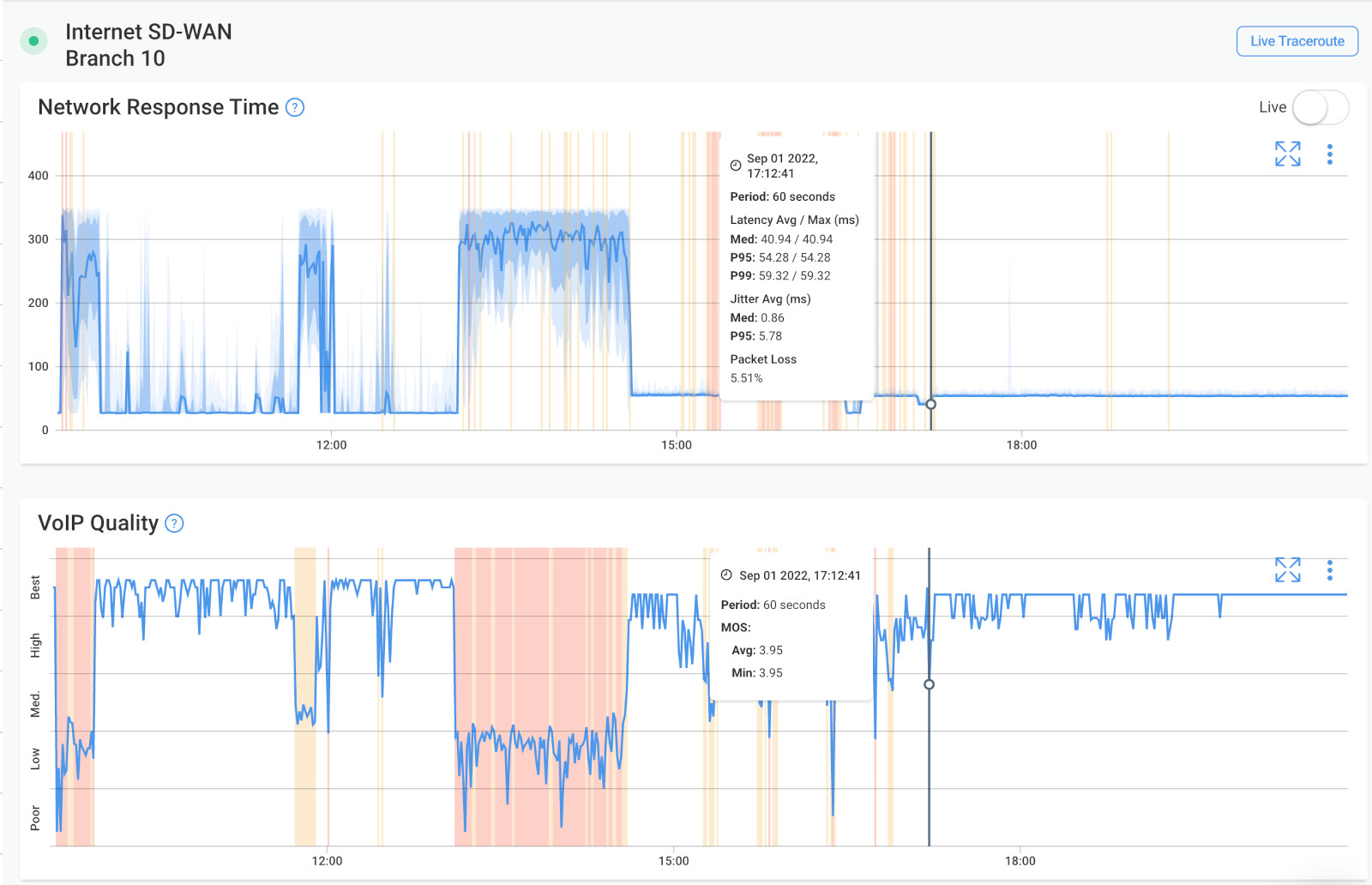
By monitoring these network metrics, you can proactively identify and address performance issues, optimize your network, and maintain a reliable and efficient Meraki SD-WAN infrastructure.
Stay Ahead of the Game: Proactively Troubleshoot SD-WAN Issues with Obkio + Meraki SD-WAN Network Monitoring
Follow our complete guide about SD-WAN Troubleshooting using Obkio
Here is a quick summary:
SD-WAN networks are designed to provide better network performance and reliability, but issues can still occur. In this section, we will cover the steps to troubleshoot SD-WAN network issues. Before we dive into the steps, it's important to understand where SD-WAN issues can occur and what problems may arise.
SD-WAN issues can happen in the underlay, overlay, or LAN. Some common SD-WAN issues include defective cables or connectors, bandwidth congestion, device misconfigurations, device software issues, high CPU usage, physical or hardware issues, human errors, and DNS issues.

To monitor SD-WAN performance, it's important to have end-to-end visibility of the ISP network and the Internet, which SD-WAN networks depend on to ensure good performance.
To achieve this, you need to monitor your network to identify performance issues. Obkio's Network Performance Monitoring software can be a valuable tool for monitoring your SD-WAN network's end-to-end performance and identifying issues with automatic alerts and the Chord Diagram feature.

The SD-WAN troubleshooting steps include pinpointing the issues, identifying when and where the problem occurred, analyzing the data to find the root cause, and implementing a solution. Obkio's Dashboard and Visual Traceroute tools can help you to analyze the data and identify the root cause of the issue.
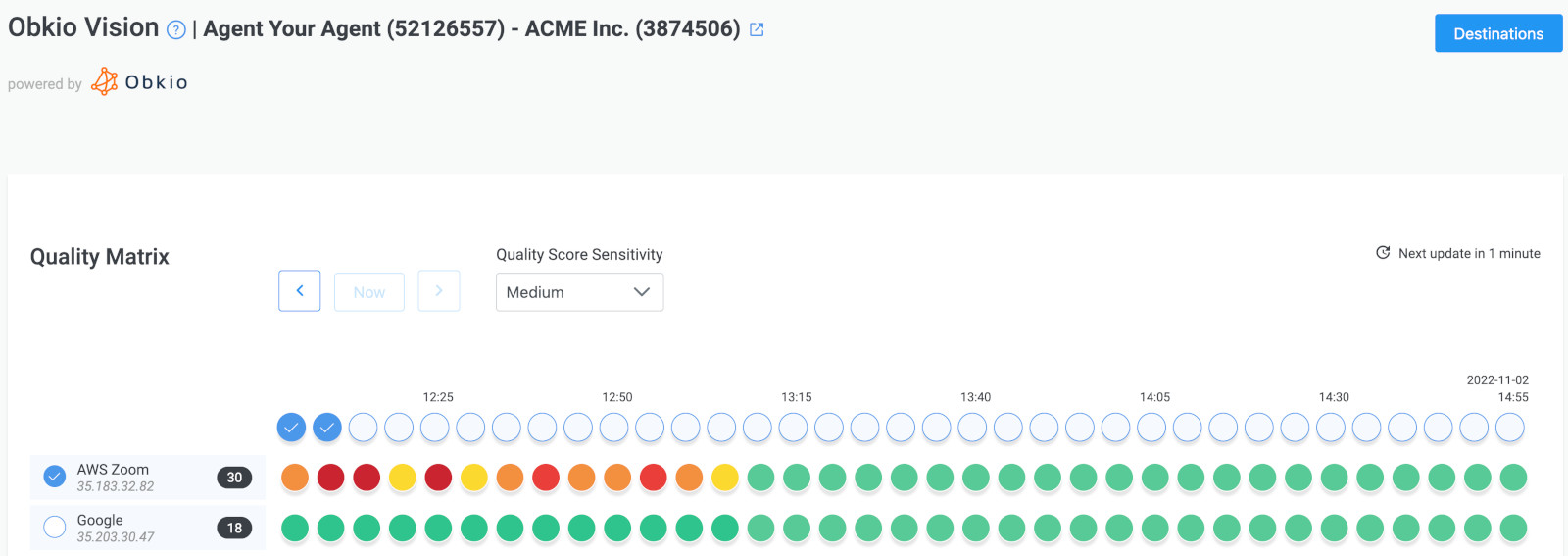 Obkio Vision Quality Matrix
Obkio Vision Quality Matrix
 Obkio Vision Network Map
Obkio Vision Network Map
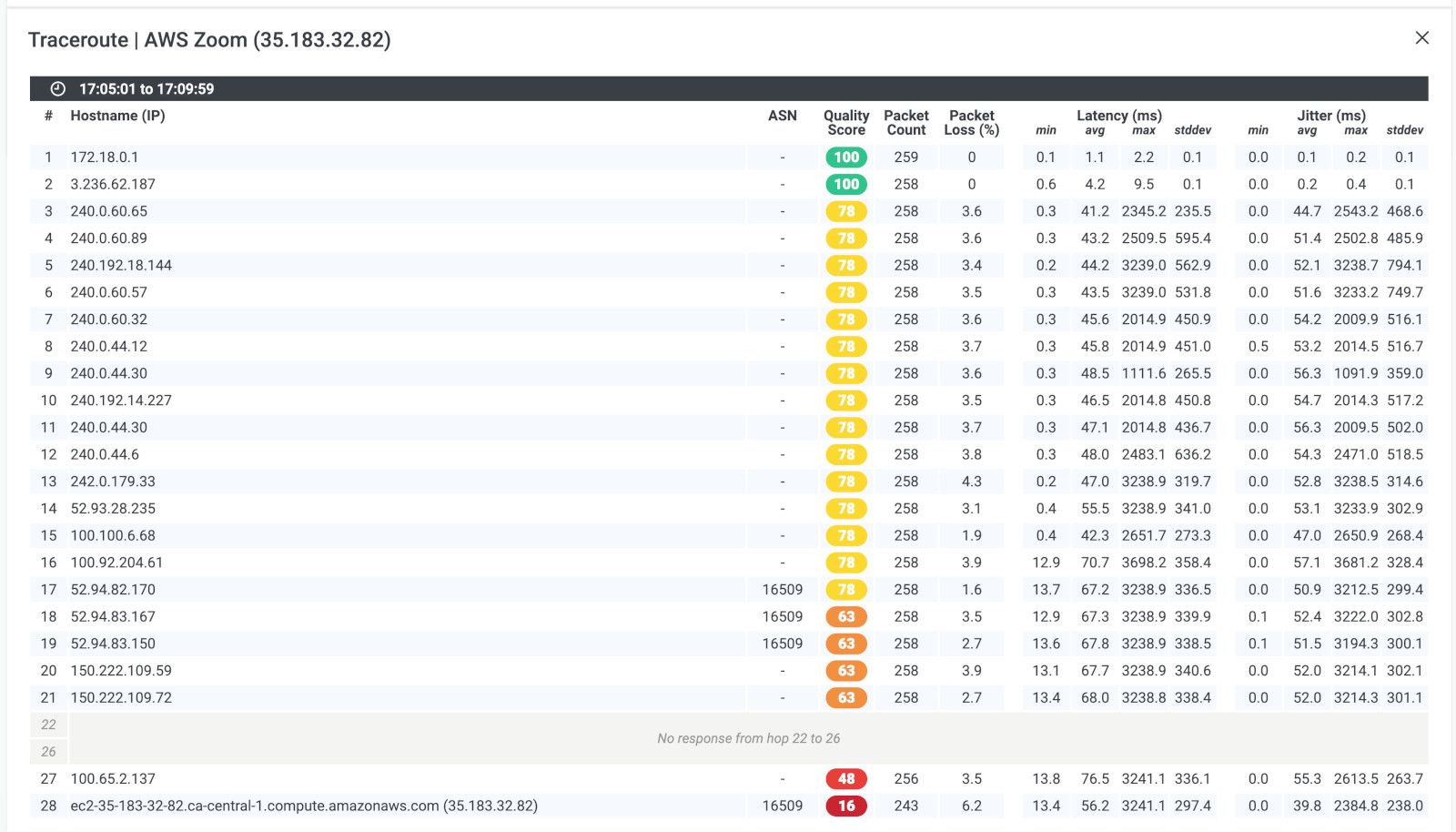 Obkio Vision Traceroutes
Obkio Vision Traceroutes
Once you've identified the problem and who is responsible for solving it, you can take action to implement a solution. If the problem is on your ISP's side, contact them to get technical support. If the problem is on your end, consider managing priorities in your firewall, upgrading your internet connection bandwidth, or upgrading your device to a bigger one.
By following these steps and using the right tools, you can proactively solve SD-WAN issues before they affect user experience. With Obkio's Network Performance Monitoring software, you can ensure optimal SD-WAN performance and identify and resolve issues quickly and efficiently.
Implementing and managing a Meraki SD-WAN can be transformative for your network infrastructure, but it's not without its share of challenges. From network congestion and packet loss to security vulnerabilities and application performance, various issues can surface during your SD-WAN journey.
When you're monitoring your Meraki SD-WAN service, you may come across some of these issues, so let's get ahead of the game!
Businesses may encounter various issues when implementing and managing Meraki SD-WAN. Some common challenges include:
Network Congestion: The increased use of bandwidth-intensive applications can lead to network congestion, causing slow performance and reduced user experience.
Packet Loss: Packet loss can disrupt data transmission, leading to poor-quality voice and video calls, lag in applications, and decreased network performance.
Latency: High latency can result in delays in data transmission, impacting real-time applications like video conferencing and VoIP.
Security Vulnerabilities: While Meraki SD-WAN is designed with security in mind, misconfigurations or unpatched devices can expose the network to vulnerabilities.
Complexity of Network Policies: Creating and managing network policies, including QoS settings and application prioritization, can be challenging for organizations with limited networking expertise.
Interoperability Issues: Integrating Meraki SD-WAN with existing network infrastructure and ensuring compatibility with various devices and services can be complex.
Application Performance: Ensuring optimal performance for critical applications can be a challenge, especially during periods of high network traffic.
Failover and Redundancy: Configuring network failover and redundancy for WAN links to maintain network continuity in case of a link failure requires careful planning.
Reporting and Visibility: Obtaining comprehensive visibility into network performance, security, and user activity can be a hurdle without the right monitoring tools.
Remote Troubleshooting: Diagnosing and addressing issues in remote offices or branches can be challenging without physical access to the equipment.
To mitigate these challenges, organizations often rely on network monitoring and management solutions, like Meraki Network Monitoring Software, which provide real-time insights, historical data, and troubleshooting capabilities to ensure optimal SD-WAN performance and security.
Many people rely on SD-WAN networks, but they’re still prone to network issues. Learn about the 3 most common SD-WAN issues and how to solve them.
Learn more

As we near the end of this article, we're excited to provide you with some essential tips to ensure your Meraki SD-WAN operates at its best. These strategies will help you fine-tune your network, improve efficiency, and maintain a reliable and high-performing SD-WAN infrastructure. Whether you're new to SD-WAN or an experienced network professional, these tips will empower you to make the most of your Meraki SD-WAN deployment. Let's dive in and optimize your network performance!
1. Understand Your Traffic:
Start by gaining a comprehensive understanding of your network traffic. Identify critical applications and prioritize them using Quality of Service (QoS) settings. This ensures that essential applications receive the necessary network resources.
2. Bandwidth Allocation:
Allocate bandwidth based on the specific needs of your applications. Assign more bandwidth to mission-critical applications and less to less time-sensitive ones.
3. Optimize WAN Links:
Leverage the multiple WAN links available in your SD-WAN setup. Distribute traffic intelligently across these links, using load balancing and path selection to ensure efficient usage and maximize network performance.
4. Monitor and Analyze:
Regularly monitor your network's performance and analyze the data collected. Meraki Network Monitoring Software can help you gain insights into network metrics, application performance, and potential issues.
5. Failover Configuration:
Set up failover mechanisms to ensure network continuity in case of WAN link failures. This redundancy is vital for maintaining seamless network operations.
6. Security Measures:
Implement robust security measures to protect your network from threats and vulnerabilities. Meraki's integrated security features can help safeguard your network.
7. Optimize Cloud Connectivity:
If your business relies on cloud applications, ensure that your SD-WAN configuration is optimized for the best cloud performance. Meraki's Auto VPN and SD-WAN capabilities can help improve connectivity to cloud resources.
8. Network Policies:
Review and refine your network policies periodically. Ensure that they align with your current business needs and performance requirements.
9. Historical Data Analysis:**
Analyze historical data to identify performance trends and areas that may require optimization. This can help you make data-driven decisions to improve network efficiency.
10. Collaborate with Meraki Support:
Don't hesitate to reach out to Meraki support or your managed service provider if you encounter performance issues you can't resolve. They can provide guidance and assistance in optimizing your SD-WAN configuration.
By following these tips, you can make the most of your Meraki SD-WAN deployment, ensuring that it operates efficiently and effectively to meet your business needs.
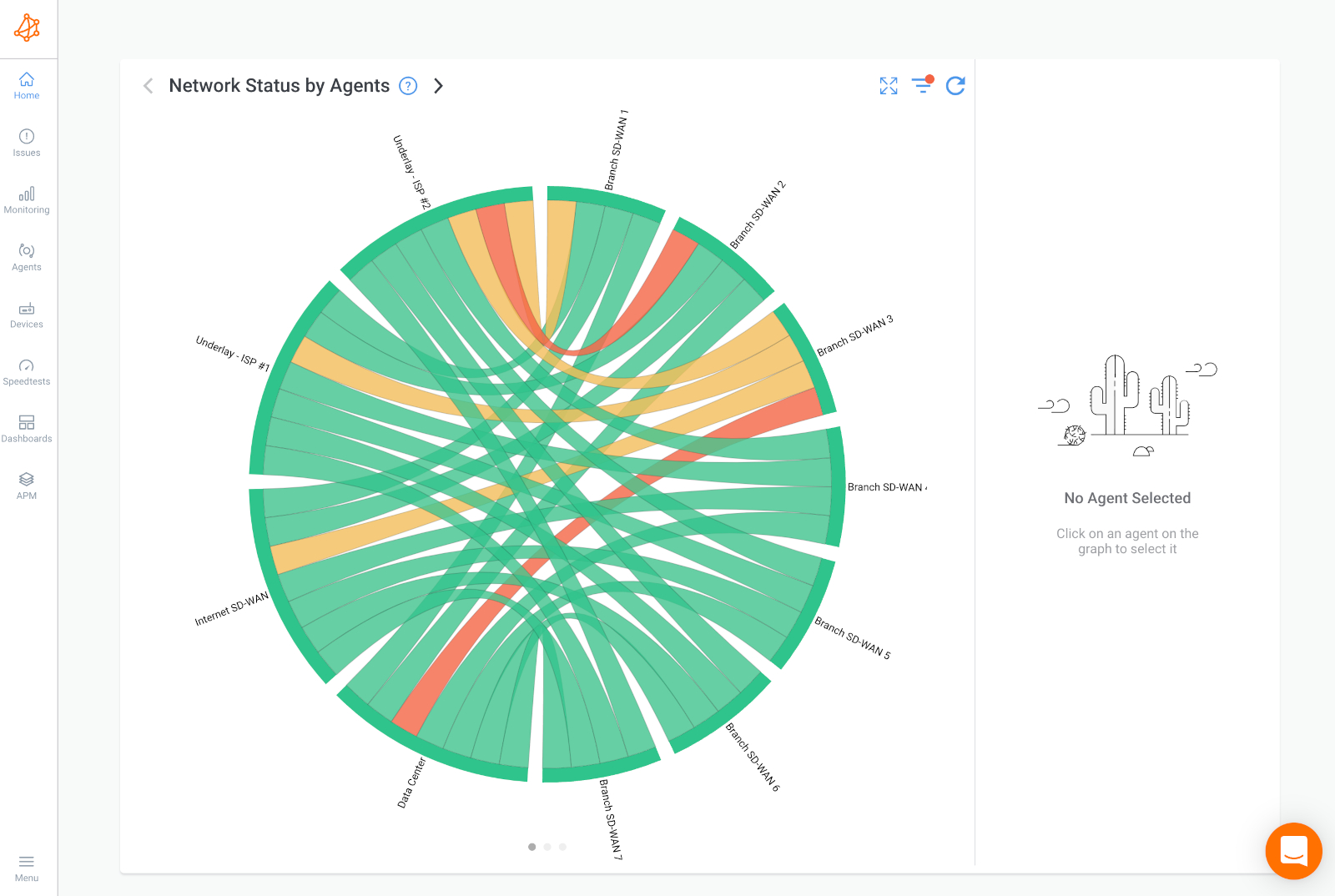

Congratulations! You're now a pro at understanding the benefits and challenges of managing an SD-WAN network. With the rising popularity of SD-WAN networks, it's more important than ever to have the right tools in place to ensure optimal performance.
Obkio Network Performance Monitoring software is the key to unlocking the full potential of your SD-WAN network. Whether you're troubleshooting issues with defective cables, battling bandwidth congestion, or dealing with pesky human errors, Obkio's visual tools and network monitoring agents make it easy to identify and resolve issues quickly.

So, what are you waiting for? Give Obkio's Network Performance Monitoring software a spin with a free trial and see the difference for yourself. With Obkio, you can sit back, relax, and watch as your SD-WAN network runs like a dream.
- 14-day free trial of all premium features
- Deploy in just 10 minutes
- Monitor performance in all key network locations
- Measure real-time network metrics
- Identify and troubleshoot live network problems

Here are a few jokes about network monitoring:
- Why did the network administrator install a security camera in the server room? To monitor his servers and make sure they didn't catch a virus!
- What's a network administrator's favorite kind of candy? Peppermint LAN-es!
- Why did the network engineer refuse to go to the movies? Because he didn't want to be stuck in a firewall!
- Why did the network administrator break up with his girlfriend? She kept ping-ing him all the time!
- Why did the network monitoring software go to the therapist? To get over its packet-loss issues!
I hope those gave you a good laugh!












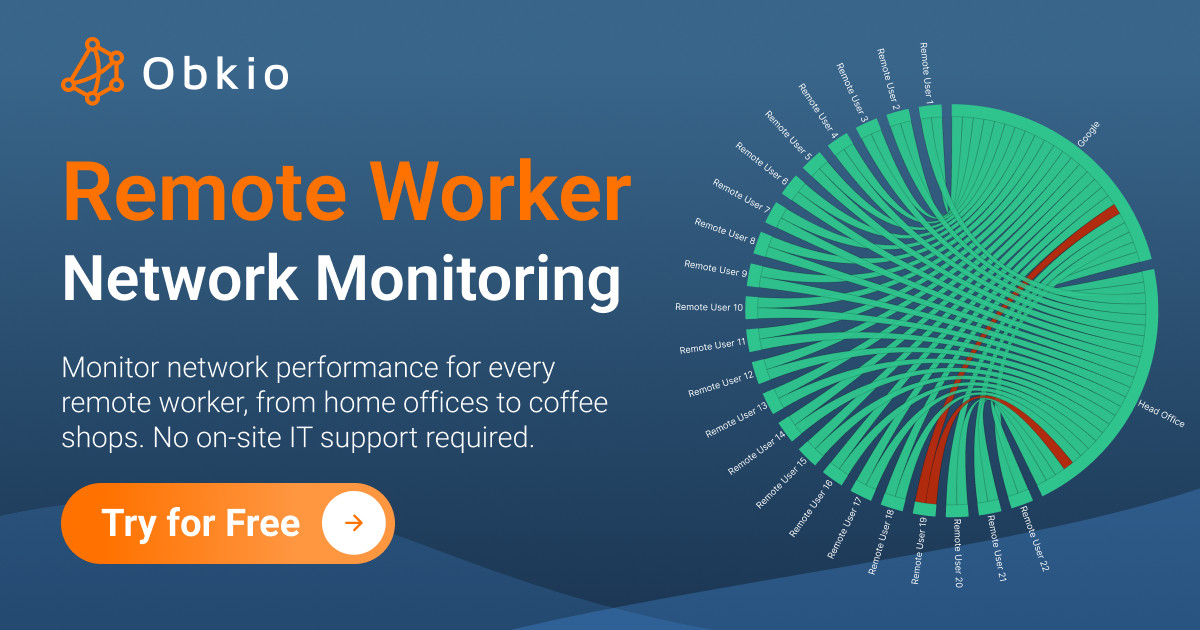













 Obkio Blog
Obkio Blog








